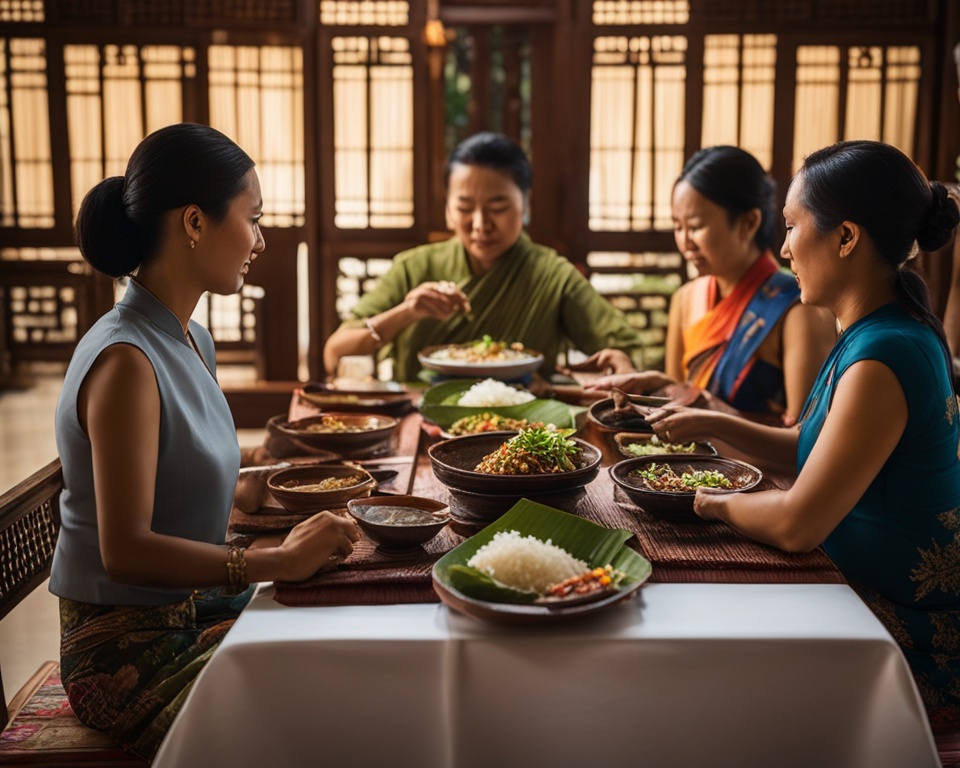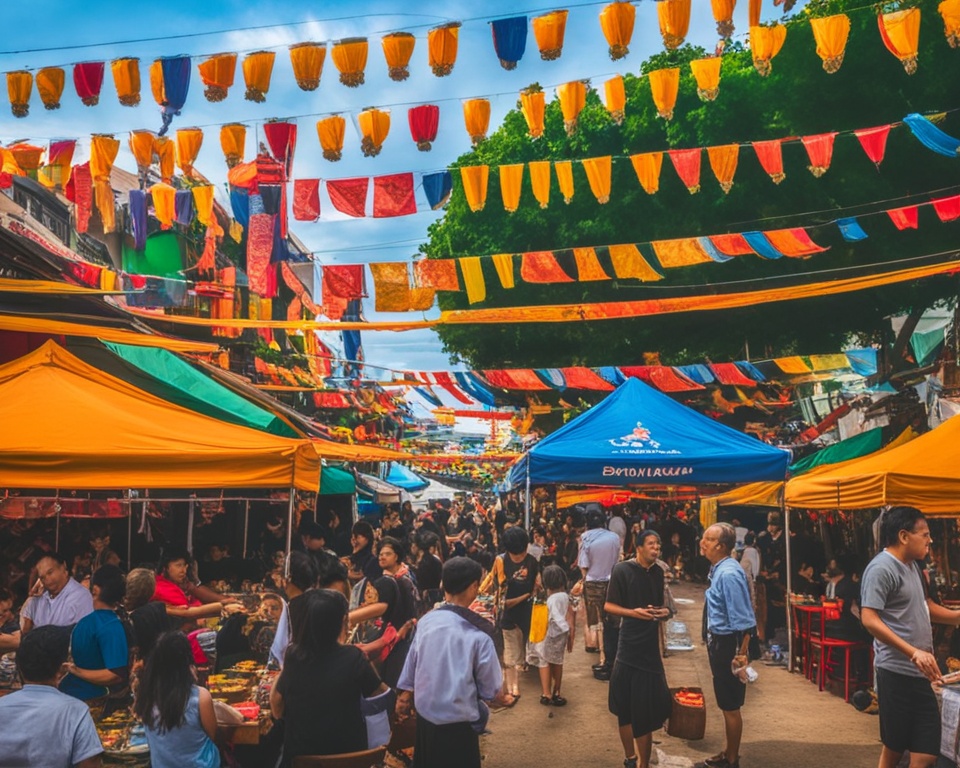Thai cuisine is renowned for its bold, complex flavors that harmoniously balance spicy, sour, sweet, and salty elements. From the fragrant curries to the tantalizing street food, Thai food offers a delightful culinary experience that has captivated food enthusiasts worldwide. In this article, we’ll explore the vibrant and diverse flavors of Thai cuisine, examine its health benefits, discover popular dishes, and dive into the art of authentic Thai cooking. Whether you’re a seasoned Thai food lover or new to this exotic fare, you’re in for a delicious journey.
Read more interesting information at ::zcr157602
The Vibrant and Complex Flavors of Thai Cuisine
Thai cuisine is renowned for its unique ability to harmoniously blend sweet, sour, salty, and spicy flavors. This balance is achieved through the careful selection and combination of various herbs, spices, and ingredients. The foundations of Thai cooking include fragrant lemongrass, galangal, kaffir lime leaves, and fresh herbs like cilantro, basil, and mint. These ingredients, along with chili peppers, fish sauce, lime juice, and palm sugar, create the signature Thai taste that is both complex and deeply satisfying.
Balancing Sweet, Sour, Salty, and Spicy
The art of Thai cooking involves mastering the nuanced interplay of these bold flavors to create dishes that are both visually stunning and bursting with taste. Each component plays a crucial role in the overall flavor profile, with the perfect balance of sweet, sour, salty, and spicy elements elevating the dining experience.
The Art of Thai Herbs and Spices
At the heart of authentic Thai cooking lies the intricate use of herbs and spices. From the fragrant lemongrass to the tangy kaffir lime leaves, these ingredients are meticulously combined to create the complex and captivating flavors that define Thai cuisine. The judicious application of chili peppers, fish sauce, and palm sugar further enhances the depth and complexity of these dishes, showcasing the culinary artistry of Thai chefs.
Is Thai Food Good for Your Health?
Thai cuisine is not only delicious but also incredibly healthy. The core ingredients used in Thai cooking, such as fresh vegetables, lean proteins, and an abundance of herbs and spices, are packed with essential vitamins, minerals, and antioxidants. Dishes like tom yum goong (spicy shrimp soup) and som tam (papaya salad) are brimming with nutrient-dense ingredients that can support overall health and well-being.
Nutrient-Rich Ingredients
The vibrant and flavorful ingredients that are the foundation of Thai cuisine offer a wealth of health benefits. From the anti-inflammatory properties of lemongrass and galangal to the immune-boosting power of fresh herbs like cilantro and basil, Thai dishes are packed with powerful nutrients that can promote overall well-being.
Moderation is Key
However, it’s important to note that some Thai dishes, particularly those with rich coconut milk or deep-fried elements, may be higher in calories and fat. Practicing moderation and balance when enjoying Thai food can help ensure that you reap the full health benefits of this vibrant cuisine.
Popular Thai Dishes to Savor
Thai cuisine offers a diverse array of delectable dishes that have captivated food enthusiasts around the world. One of the most iconic Thai dishes is tom yum goong, a fragrant and spicy shrimp soup that showcases the perfect harmony of sweet, sour, and spicy flavors.
Tom Yum Goong: The Iconic Thai Soup
This beloved Thai classic features a broth infused with lemongrass, galangal, kaffir lime leaves, and a medley of fresh herbs and spices. The addition of juicy shrimp, tangy lime juice, and a hint of fish sauce creates a symphony of flavors that is both invigorating and deeply satisfying.
Pad Thai: A Beloved Noodle Dish
Another beloved Thai dish is pad thai, a stir-fried rice noodle dish featuring shrimp, eggs, bean sprouts, and a tantalizing sauce. The perfect balance of sweet, sour, and savory notes in the pad thai sauce, combined with the texture of the noodles and the crunch of the bean sprouts, makes this dish a perennial favorite among popular thai dishes and in best thai restaurants around the world.
These dishes, along with other popular thai dishes like massaman curry, khao niaow ma muang (mango sticky rice), and laab (spicy minced meat salad), have contributed to the widespread popularity of Thai cuisine, earning it a place among the best thai restaurants and in thai restaurant reviews.
Exploring the Diverse Regional Cuisines of Thailand
Thailand’s rich culinary heritage is not limited to a single style of cooking; rather, it encompasses a diverse array of regional Thai cuisines, each with its own unique flavor profile and signature dishes. From the aromatic curries of the central region to the fiery northern specialties and the seafood-centric dishes of the southern provinces, Thai cuisine offers a remarkable depth of flavors and culinary traditions.
Exploring these regional variations provides a deeper appreciation for the complexity and diversity of authentic Thai cooking, showcasing how geography, culture, and local ingredients have shaped the country’s vibrant gastronomic landscape. By delving into the distinctive regional cuisines of Thailand, food enthusiasts can uncover a wealth of flavors and culinary treasures that collectively contribute to the rich tapestry of Thai cuisine.
Authentic Thai Cooking: Recreating the Flavors at Home
Preparing authentic Thai dishes at home can be a rewarding and flavorful endeavor. The key to recreating the signature tastes of Thai cuisine lies in understanding the essential ingredients and mastering the fundamental cooking techniques.
Essential Thai Ingredients and Cooking Techniques
Staple Thai ingredients like fish sauce, coconut milk, lemongrass, galangal, and a variety of fresh herbs and chili peppers are the building blocks of many Thai dishes. Techniques such as the wok-tossing method, the use of a mortar and pestle for making curry pastes, and the careful balance of sweet, sour, salty, and spicy flavors are all integral to authentic Thai cooking.
Traditional Thai Recipes to Try
By exploring traditional Thai recipes and incorporating these essential elements, home cooks can bring the vibrant and complex flavors of Thailand into their own kitchens. From fragrant curries to tantalizing stir-fries, Thai food recipes offer a diverse range of dishes that allow you to experience the true essence of this captivating cuisine.
Thai Street Food: A Culinary Adventure
Exploring the vibrant thai street food scene is an essential part of experiencing the true essence of Thai cuisine. Thai street food offers a tantalizing array of dishes that showcase the country’s culinary prowess and the ingenuity of its people. From the sizzling pad Thai noodles to the aromatic khao niaow ma muang (mango sticky rice), the eclectic selection of thai street food delicacies is a testament to the creativity and resourcefulness of Thai cooks.
Venturing into the bustling night markets and street stalls provides an opportunity to immerse oneself in the lively atmosphere and savor the authentic flavors that have made thai street food a beloved global phenomenon.
Must-Try Thai Street Food Delicacies
The vibrant thai street food scene offers a mouthwatering array of dishes that showcase the country’s rich culinary heritage. From the sizzling pad Thai noodles to the fragrant khao niaow ma muang (mango sticky rice), these street food specialties captivate the senses and provide a true taste of Thailand.
| Dish | Description |
|---|---|
| Pad Thai | A beloved stir-fried rice noodle dish featuring shrimp, eggs, bean sprouts, and a tantalizing sauce. |
| Khao Niaow Ma Muang | A sweet and creamy dessert made with sticky rice, fresh mango, and a coconut milk-based sauce. |
| Som Tam | A spicy and refreshing papaya salad with a harmonious blend of sour, sweet, and salty flavors. |
| Moo Ping | Grilled pork skewers that are marinated in a savory and aromatic blend of fish sauce, cilantro, and spices. |
These thai street food delicacies, along with countless other regional specialties, offer a tantalizing glimpse into the culinary creativity and ingenuity of Thailand’s street food scene.
Is Thai Food Good for Vegetarians and Vegans?
Thai cuisine is not just for meat-lovers; it also offers an abundance of delicious and nutritious options for vegetarians and vegans. Many traditional Thai dishes can be easily adapted to accommodate plant-based diets, with the abundant use of fresh vegetables, tofu, and an array of flavorful herbs and spices.
Plant-Based Thai Dishes
Dishes like vegetable curries, stir-fried morning glory, and meatless versions of classic Thai salads and soups provide satisfying and flavor-packed options for those following a vegetarian or vegan lifestyle. These healthy thai dishes showcase the versatility of Thai cuisine in catering to a wide range of dietary preferences.
Navigating Thai Menus as a Vegetarian or Vegan
When dining at Thai restaurants, it’s important to be mindful of ingredients and preparation methods, as some dishes may contain fish sauce or other non-vegan components. With a little research and communication with the staff, vegetarians and vegans can navigate Thai menus and enjoy the vibrant, plant-based offerings of this cuisine.
The Best Thai Restaurants: Where to Find Authentic Thai Flavors
Discovering the best Thai restaurants is key to experiencing the authentic flavors and traditional cooking techniques of this beloved cuisine. From bustling urban centers to quaint suburban neighborhoods, dedicated Thai eateries can be found around the world, each offering their own interpretation of classic dishes and regional specialties.
Seeking Out Thai Food Hotspots
When seeking out the top Thai restaurants, look for establishments that source high-quality ingredients, employ skilled Thai chefs, and maintain a commitment to time-honored recipes and cooking methods. Online reviews, recommendations from local foodie communities, and even word-of-mouth from fellow Thai food enthusiasts can be valuable resources in your quest to find the most authentic and delectable Thai dining experiences.
| Top-Rated Thai Restaurants | Signature Dishes | Average Price Range |
|---|---|---|
| Nusara, Bangkok | Massaman Curry, Khao Soi | $30 – $50 per person |
| Raan Jay Fai, Bangkok | Crab Omelet, Drunken Noodles | $30 – $60 per person |
| Nahm, Bangkok | Tom Yum Goong, Pad Thai | $40 – $70 per person |
| Paste, Bangkok | Gaeng Khua Baan Poo, Moo Ping | $35 – $60 per person |
These renowned Thai restaurants showcase the diversity and depth of the country’s culinary heritage, offering diners a chance to savor the most authentic and delectable flavors of Thailand.
Thai Food Etiquette: Embracing Cultural Traditions
Enjoying authentic Thai cooking and Thai cuisine is not just about the flavors on the plate; it also involves embracing the cultural traditions and etiquette associated with this vibrant culinary heritage. From the proper way to use chopsticks or a spoon and fork to understanding the significance of sharing dishes family-style, familiarizing oneself with Thai dining customs can enhance the overall dining experience.
Additionally, being mindful of how to properly handle and consume certain Thai ingredients, such as whole fish or sticky rice, demonstrates respect for the culinary traditions. By embracing these cultural nuances, diners can more fully immerse themselves in the authentic Thai dining experience and gain a deeper appreciation for the customs that have been passed down through generations.
| Thai Dining Etiquette | Significance |
|---|---|
| Proper Utensil Usage | Using chopsticks or a spoon and fork in the correct manner shows respect for Thai customs. |
| Family-Style Sharing | Sharing dishes and passing them around the table is a traditional Thai practice that fosters community and togetherness. |
| Handling Whole Fish | Delicately separating the meat from the bone when eating whole fish is a skill that demonstrates respect for the ingredient. |
| Consuming Sticky Rice | Using the fingers to pinch and shape sticky rice into small balls is a common Thai dining tradition. |
By embracing these cultural nuances, diners can more fully immerse themselves in the authentic Thai cuisine experience and gain a deeper appreciation for the customs that have been passed down through generations.

The History and Evolution of Thai Cuisine
Thai cuisine has a rich and diverse history, evolving over centuries through cultural exchanges and the influence of neighboring countries. Neighboring cuisines, such as those of China, India, and Malaysia, have all contributed to the development of Thai cooking, with ingredients and techniques being adapted and integrated into the Thai culinary tradition.
Influences from Neighboring Countries
The proximity of Thailand to other Southeast Asian nations has resulted in a cross-pollination of culinary ideas and ingredients. The flavors and cooking methods of China, India, and Malaysia have all left their mark on the authentic thai cooking techniques and recipes that have become the hallmark of Thai cuisine. This cultural exchange has enriched the diversity of Thai food, allowing it to continuously adapt and evolve while maintaining its distinct identity.
Modern Twists on Traditional Thai Dishes
While maintaining the core elements of traditional thai cuisine, modern Thai chefs have also experimented with innovative interpretations, fusing international influences and presenting time-honored dishes in novel ways. This dynamic interplay between heritage and innovation has allowed Thai cuisine to continuously evolve, while still preserving the essence of its time-honored culinary legacy. From contemporary plating techniques to the incorporation of global ingredients, Thai food has adapted to the changing tastes and preferences of modern diners, yet still firmly rooted in its rich cultural traditions.
The Spice Factor: Is Thai Food Too Spicy?
Thai cuisine is renowned for its bold and often spicy flavors, which can sometimes be intimidating for those unaccustomed to such heat. However, the level of spiciness in Thai dishes can be adjusted to suit individual preferences. Many Thai restaurants are happy to accommodate requests for milder versions of certain dishes, allowing diners to enjoy the complex thai flavors and spices without overwhelming their palates.
Additionally, being mindful of ingredients like fresh chili peppers and Thai chili pastes can help diners manage the spice factor when cooking Thai food at home. By exploring the nuances of Thai spices and experimenting with different levels of heat, food enthusiasts can find the sweet spot where they can fully savor the vibrant and harmonious flavors of Thai cuisine.
Adjusting Spice Levels to Your Taste
While is thai food too spicy can be a valid concern for some, the good news is that the spice level in Thai dishes can be customized to individual preferences. Many Thai restaurants are well-versed in catering to diners with different spice tolerances, and they are often happy to adjust the amount of chili peppers or spicy sauces used in a dish upon request.
By communicating your desired level of spiciness to the server or chef, you can enjoy the complex flavors of Thai cuisine without compromising your comfort. Additionally, familiarizing yourself with common Thai spices and their relative heat levels can help you make informed choices when ordering or cooking Thai food at home.
Thai Food Festivals and Events
Thai cuisine is not just a culinary experience; it is an integral part of Thai culture, celebrated through various festivals and events around the world. These festivals offer an opportunity to immerse oneself in the rich tapestry of Thai traditions, music, dance, and, of course, the delectable flavors of authentic thai cuisine.
Celebrating Thai Culture and Cuisine
From the colorful Songkran water festival to the lively Thailand Grand Festival, these events showcase the country’s vibrant cultural heritage and provide a platform for both Thai and international food enthusiasts to come together and revel in the joy of authentic thai cooking. Attending these festivals can be a transformative experience, allowing visitors to deepen their understanding and appreciation for the multifaceted nature of Thai culinary traditions.

Expert Tips for Ordering Thai Food
Ordering Thai food, especially at an authentic Thai restaurant, can be a delightful yet sometimes daunting experience for the uninitiated. However, with a few expert tips, you can navigate Thai restaurant menus and communicate your dietary preferences to ensure a satisfying dining experience.
Navigating Thai Restaurant Menus
When exploring Thai restaurant menus, it’s helpful to familiarize yourself with the common dish categories, such as curries, salads, noodle dishes, and stir-fries. This knowledge can provide a starting point for your culinary exploration. Additionally, being open to trying new and unfamiliar items can lead to the discovery of unexpected culinary gems that showcase the depth and diversity of Thai cuisine.
Communicating Dietary Preferences
When communicating your dietary needs or restrictions, it’s essential to politely inform the staff of any allergies, intolerances, or preferences. This allows the kitchen to accommodate your requirements and provide you with the best possible Thai dining experience. Many Thai restaurants are well-versed in catering to various dietary needs, so don’t hesitate to ask about vegetarian, vegan, or gluten-free options that may be available.
By following these expert tips, you can navigate Thai restaurant menus with confidence and ensure that your Thai food experience is both delightful and tailored to your individual preferences.
Conclusion
In conclusion, Thai cuisine is a true culinary delight that offers a harmonious blend of flavors, textures, and aromas. From the vibrant and complex flavors to the health benefits of its nutrient-rich ingredients, Thai food has captivated the hearts and palates of food enthusiasts worldwide. Whether you’re exploring the diverse regional cuisines, savoring the delectable street food, or recreating authentic Thai dishes at home, the journey of discovering the wonders of Thai cuisine is one that promises a truly rewarding and delicious experience.
By embracing the cultural traditions, understanding the art of Thai cooking, and finding the best Thai restaurants, you can fully immerse yourself in the exquisite and flavorful world of Thai gastronomy. With its perfect balance of sweet, sour, salty, and spicy elements, Thai food offers a captivating culinary adventure that will leave you craving for more. Embark on this flavorful journey and let the vibrant and complex tastes of Thai cuisine transport you to the heart of this remarkable culinary heritage.
